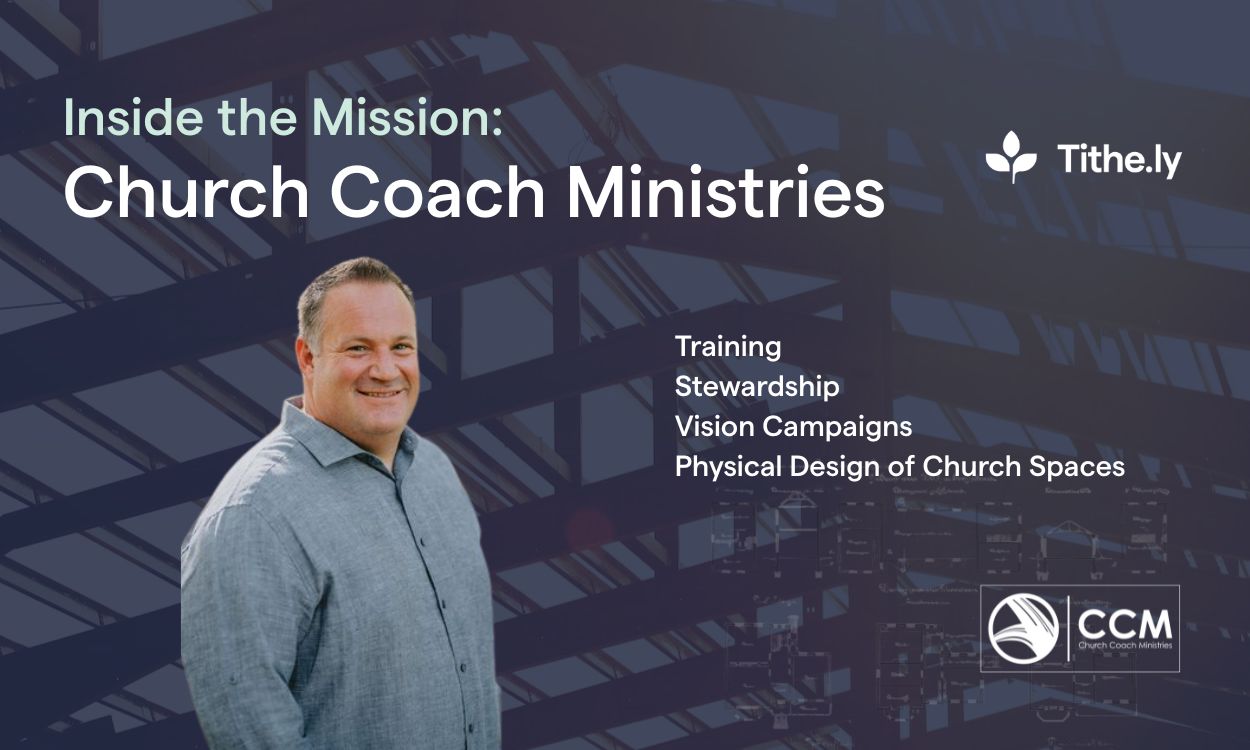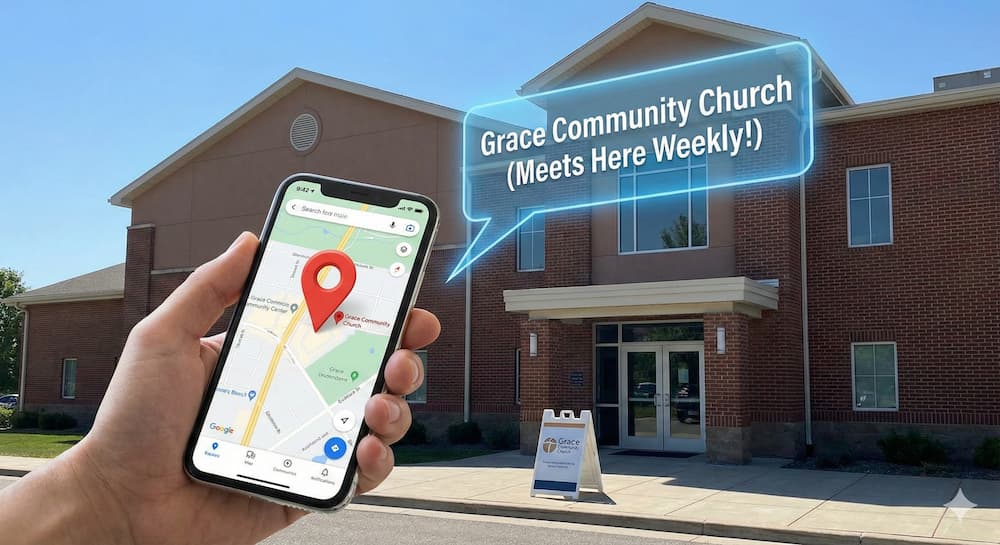Understanding Major Givers in Your Church
Use these three simple strategies to understand the major givers in your church.

Did you know that misunderstanding the major givers in your church could be impacting your budget, your relationships, and the hearts of your givers?
In working with hundreds of pastors and thousands of givers around the country, and I’ve learned what works and what doesn’t when it comes to giving in the church.
Before we can discuss how to increase giving, it’s important to understand the three types of givers in your church. Every church has them all. I like to call them:
1. Cheerful Giver
2. Grumpy Giver
3. No Giver
These simple titles clearly describe the state of the heart of every single person who walks through your church doors. And we know that God desires to move people toward cheerful giving. So, how do you do that?
Here,I’m going to supply you with the three strategies for engaging givers that I’ve seen increase real giving in real churches in real time. These strategies should guide you as you help guide your givers from grumpy to cheerful.
Looking for more? Check out the full guide with practical tips from I Like Giving.
1. EstablishAuthentic Relationships
Be intentional about connecting with givers.Develop a system for staying in touch, whether it’s texting, email messages, personal notes, phone calls, etc. This could mean once a month, once a quarter, or twice a year. You need to find the rhythm that works for you or else it won’t get done.
Seek to know and understand the person behind the resources.
Wealthy individuals may wonder, “do they just want to get something from me?” Get to know who they are. What are their passions, interests, skills, and talents? How do these characteristics circle back to the church and its mission? Resources often flow from an established relationship.
Trust is a key element in relationships and is built over time as people get to know one another. Show them you can be trusted with confidential information by leading with your vulnerability. Recognize that even in today’s culture of immediacy, trust is one area that will not be instantaneous.
2. Be clear about the need
Communicate the current needs of the church in a way that invites donors to be part of fulfilling the mission.
Provide relevant and clear information that is easy for givers to access.
The concern of some major givers: I don’t know if my church can handle a large gift (do they have a vision, plan to execute, and will they communicate results back?).
3. Share the Impact
Most wealthy donors have a history as successful business professionals and often view giving as an investment. As a result, they’re thinking in terms of ROI. It’s important to communicate the results related to their generosity.
Here are a few tips:
- Send updates: Send donors specific updates about how their gift has supported the church’s mission and empowered its ministries.
- Get personal: Sharing personal stories that are a result of their gift will inspire donors for future giving.
- Show evidence: Illustrate the ways their gift may have reached beyond the church and helped transform the community.
- Respond: Writing a brief handwritten note to your givers is a meaningful way to express your gratitude for their generosity.
- Listen well: Saying less is often more. Try to hear their hearts in response to what you share with them.
Over to you
In all of this, remember: Be their pastor first.
I’m here to encourage you: Giving doesn’t have to be a challenging area of ministry for your church! Over time, through the work of the Holy Spirit and your intentional relationship building, you will see a healthy and thriving culture of generosity grow in your congregation.
Looking for more resources from Brad and theI Like Giving team? Visit ilikegiving.com
Sign Up for Product Updates
Did you know that misunderstanding the major givers in your church could be impacting your budget, your relationships, and the hearts of your givers?
In working with hundreds of pastors and thousands of givers around the country, and I’ve learned what works and what doesn’t when it comes to giving in the church.
Before we can discuss how to increase giving, it’s important to understand the three types of givers in your church. Every church has them all. I like to call them:
1. Cheerful Giver
2. Grumpy Giver
3. No Giver
These simple titles clearly describe the state of the heart of every single person who walks through your church doors. And we know that God desires to move people toward cheerful giving. So, how do you do that?
Here,I’m going to supply you with the three strategies for engaging givers that I’ve seen increase real giving in real churches in real time. These strategies should guide you as you help guide your givers from grumpy to cheerful.
Looking for more? Check out the full guide with practical tips from I Like Giving.
1. EstablishAuthentic Relationships
Be intentional about connecting with givers.Develop a system for staying in touch, whether it’s texting, email messages, personal notes, phone calls, etc. This could mean once a month, once a quarter, or twice a year. You need to find the rhythm that works for you or else it won’t get done.
Seek to know and understand the person behind the resources.
Wealthy individuals may wonder, “do they just want to get something from me?” Get to know who they are. What are their passions, interests, skills, and talents? How do these characteristics circle back to the church and its mission? Resources often flow from an established relationship.
Trust is a key element in relationships and is built over time as people get to know one another. Show them you can be trusted with confidential information by leading with your vulnerability. Recognize that even in today’s culture of immediacy, trust is one area that will not be instantaneous.
2. Be clear about the need
Communicate the current needs of the church in a way that invites donors to be part of fulfilling the mission.
Provide relevant and clear information that is easy for givers to access.
The concern of some major givers: I don’t know if my church can handle a large gift (do they have a vision, plan to execute, and will they communicate results back?).
3. Share the Impact
Most wealthy donors have a history as successful business professionals and often view giving as an investment. As a result, they’re thinking in terms of ROI. It’s important to communicate the results related to their generosity.
Here are a few tips:
- Send updates: Send donors specific updates about how their gift has supported the church’s mission and empowered its ministries.
- Get personal: Sharing personal stories that are a result of their gift will inspire donors for future giving.
- Show evidence: Illustrate the ways their gift may have reached beyond the church and helped transform the community.
- Respond: Writing a brief handwritten note to your givers is a meaningful way to express your gratitude for their generosity.
- Listen well: Saying less is often more. Try to hear their hearts in response to what you share with them.
Over to you
In all of this, remember: Be their pastor first.
I’m here to encourage you: Giving doesn’t have to be a challenging area of ministry for your church! Over time, through the work of the Holy Spirit and your intentional relationship building, you will see a healthy and thriving culture of generosity grow in your congregation.
Looking for more resources from Brad and theI Like Giving team? Visit ilikegiving.com
podcast transcript
Did you know that misunderstanding the major givers in your church could be impacting your budget, your relationships, and the hearts of your givers?
In working with hundreds of pastors and thousands of givers around the country, and I’ve learned what works and what doesn’t when it comes to giving in the church.
Before we can discuss how to increase giving, it’s important to understand the three types of givers in your church. Every church has them all. I like to call them:
1. Cheerful Giver
2. Grumpy Giver
3. No Giver
These simple titles clearly describe the state of the heart of every single person who walks through your church doors. And we know that God desires to move people toward cheerful giving. So, how do you do that?
Here,I’m going to supply you with the three strategies for engaging givers that I’ve seen increase real giving in real churches in real time. These strategies should guide you as you help guide your givers from grumpy to cheerful.
Looking for more? Check out the full guide with practical tips from I Like Giving.
1. EstablishAuthentic Relationships
Be intentional about connecting with givers.Develop a system for staying in touch, whether it’s texting, email messages, personal notes, phone calls, etc. This could mean once a month, once a quarter, or twice a year. You need to find the rhythm that works for you or else it won’t get done.
Seek to know and understand the person behind the resources.
Wealthy individuals may wonder, “do they just want to get something from me?” Get to know who they are. What are their passions, interests, skills, and talents? How do these characteristics circle back to the church and its mission? Resources often flow from an established relationship.
Trust is a key element in relationships and is built over time as people get to know one another. Show them you can be trusted with confidential information by leading with your vulnerability. Recognize that even in today’s culture of immediacy, trust is one area that will not be instantaneous.
2. Be clear about the need
Communicate the current needs of the church in a way that invites donors to be part of fulfilling the mission.
Provide relevant and clear information that is easy for givers to access.
The concern of some major givers: I don’t know if my church can handle a large gift (do they have a vision, plan to execute, and will they communicate results back?).
3. Share the Impact
Most wealthy donors have a history as successful business professionals and often view giving as an investment. As a result, they’re thinking in terms of ROI. It’s important to communicate the results related to their generosity.
Here are a few tips:
- Send updates: Send donors specific updates about how their gift has supported the church’s mission and empowered its ministries.
- Get personal: Sharing personal stories that are a result of their gift will inspire donors for future giving.
- Show evidence: Illustrate the ways their gift may have reached beyond the church and helped transform the community.
- Respond: Writing a brief handwritten note to your givers is a meaningful way to express your gratitude for their generosity.
- Listen well: Saying less is often more. Try to hear their hearts in response to what you share with them.
Over to you
In all of this, remember: Be their pastor first.
I’m here to encourage you: Giving doesn’t have to be a challenging area of ministry for your church! Over time, through the work of the Holy Spirit and your intentional relationship building, you will see a healthy and thriving culture of generosity grow in your congregation.
Looking for more resources from Brad and theI Like Giving team? Visit ilikegiving.com
VIDEO transcript
Did you know that misunderstanding the major givers in your church could be impacting your budget, your relationships, and the hearts of your givers?
In working with hundreds of pastors and thousands of givers around the country, and I’ve learned what works and what doesn’t when it comes to giving in the church.
Before we can discuss how to increase giving, it’s important to understand the three types of givers in your church. Every church has them all. I like to call them:
1. Cheerful Giver
2. Grumpy Giver
3. No Giver
These simple titles clearly describe the state of the heart of every single person who walks through your church doors. And we know that God desires to move people toward cheerful giving. So, how do you do that?
Here,I’m going to supply you with the three strategies for engaging givers that I’ve seen increase real giving in real churches in real time. These strategies should guide you as you help guide your givers from grumpy to cheerful.
Looking for more? Check out the full guide with practical tips from I Like Giving.
1. EstablishAuthentic Relationships
Be intentional about connecting with givers.Develop a system for staying in touch, whether it’s texting, email messages, personal notes, phone calls, etc. This could mean once a month, once a quarter, or twice a year. You need to find the rhythm that works for you or else it won’t get done.
Seek to know and understand the person behind the resources.
Wealthy individuals may wonder, “do they just want to get something from me?” Get to know who they are. What are their passions, interests, skills, and talents? How do these characteristics circle back to the church and its mission? Resources often flow from an established relationship.
Trust is a key element in relationships and is built over time as people get to know one another. Show them you can be trusted with confidential information by leading with your vulnerability. Recognize that even in today’s culture of immediacy, trust is one area that will not be instantaneous.
2. Be clear about the need
Communicate the current needs of the church in a way that invites donors to be part of fulfilling the mission.
Provide relevant and clear information that is easy for givers to access.
The concern of some major givers: I don’t know if my church can handle a large gift (do they have a vision, plan to execute, and will they communicate results back?).
3. Share the Impact
Most wealthy donors have a history as successful business professionals and often view giving as an investment. As a result, they’re thinking in terms of ROI. It’s important to communicate the results related to their generosity.
Here are a few tips:
- Send updates: Send donors specific updates about how their gift has supported the church’s mission and empowered its ministries.
- Get personal: Sharing personal stories that are a result of their gift will inspire donors for future giving.
- Show evidence: Illustrate the ways their gift may have reached beyond the church and helped transform the community.
- Respond: Writing a brief handwritten note to your givers is a meaningful way to express your gratitude for their generosity.
- Listen well: Saying less is often more. Try to hear their hearts in response to what you share with them.
Over to you
In all of this, remember: Be their pastor first.
I’m here to encourage you: Giving doesn’t have to be a challenging area of ministry for your church! Over time, through the work of the Holy Spirit and your intentional relationship building, you will see a healthy and thriving culture of generosity grow in your congregation.
Looking for more resources from Brad and theI Like Giving team? Visit ilikegiving.com


















.jpg)









